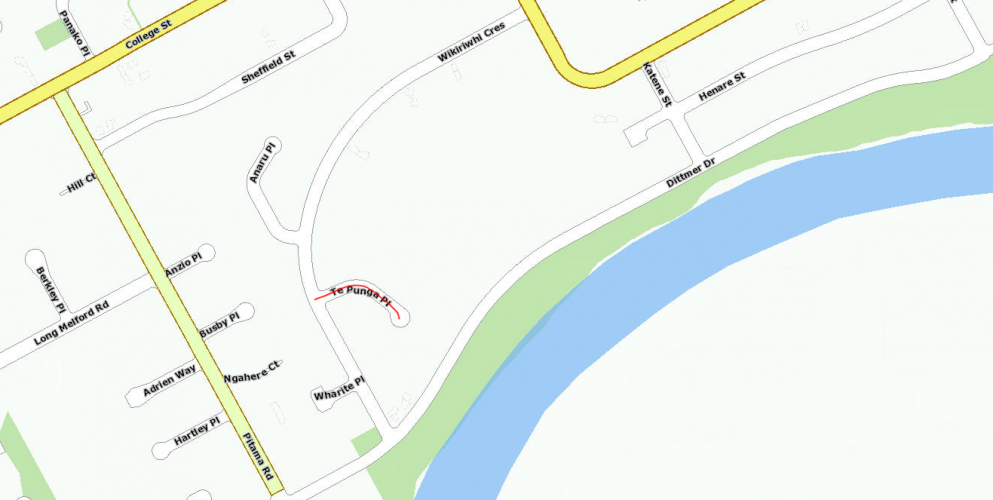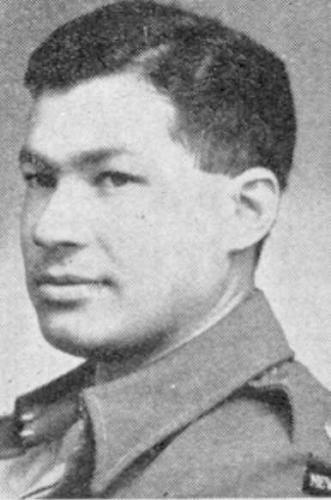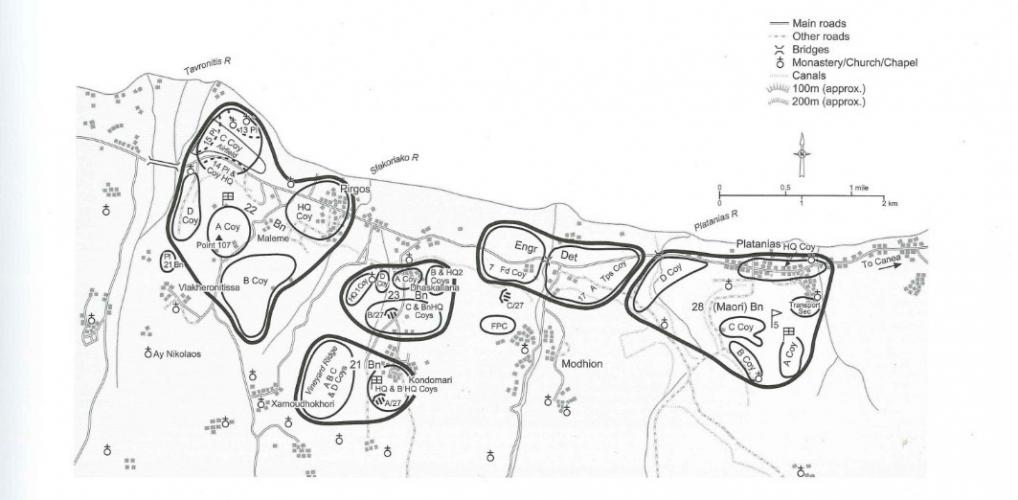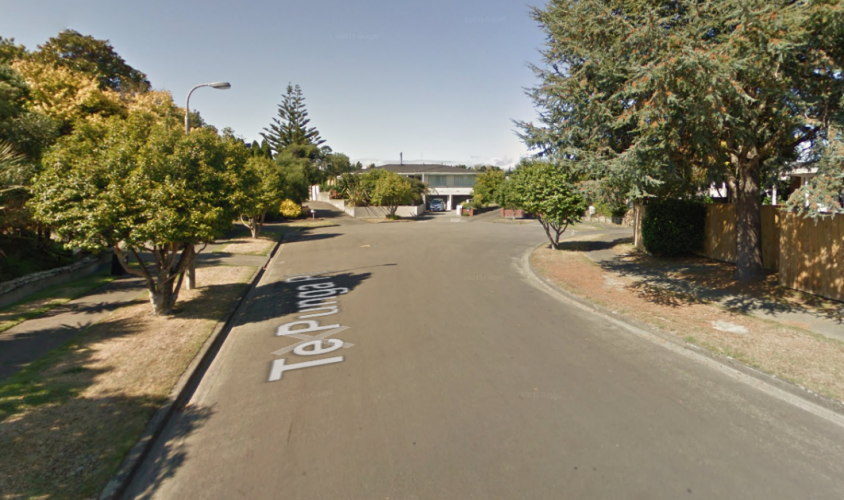098 Te Punga Place Palmerston North, street scene 2017
Reason for the name
This street was named in honour of Major Hamuera Paul Te Punga MID, 28th Maori Battalion
Prior to its subdivision the land known as Awatapu was a golf course and grazing area situated next to the Manawatu River. In order to free up land for residential development and increase revenue, a Council meeting of 16 April 1963 resolved to subdivide the area via “disposal of sections through Land Agents at pre-determined figures fixed by the Council”. The new Awatapu College had to be allowed for, and the old Awatapu Golf Links shifted upstream to Brightwater Terrace, which then became the Palmerston North Golf Club.
As part of the process of subdividing and naming streets, George Dittmer was contacted in late 1964 to give his thoughts on the naming of streets after 28th Māori Battalion soldiers as a commemoration of their service to their country. Dittmer provided a comprehensive list of soldiers who had served under him which was later utilised by the Council to adopt further street names in the Awatapu subdivision. After consultation and further correspondence with the Palmerston North City Council it was decided that the new streets in the area would be renamed in honour of these soldiers, one of which was Major Hamuera Paul Te Punga. The resolution was passed by Council on 22 November 1965 and took effect from 1 February 1966.
Te Punga Place is a small dog-leg cul-de-sac containing 17 residential houses, with its entrance and exit running off Wikiriwhi Crescent. Originally meant to run between Wikiriwhi and Manahi Street, with Rangi Crescent intersecting in its middle, Te Punga Place was completed as a much smaller street as the new Awatapu College took up the vast majority of this space after the final plan was revised (Rangi Crescent and Manahi Street were never built as a result of this). Local amenities include Awatapu College to the east, Riverdale School to the west and Dittmer Reserve, including the Manawatu River Walkway, to the south.
Author: Evan Greensides, Heritage Assistant - Archives Libraries and Community Services
Hamuera Paul Te Punga was born to Mr H & Mrs Lydia Marie Te Punga on 27 May 1916 in Lower Hutt. Educated at Halcombe & Feilding Agricultural High School, he was noted as being a “brilliant scholar” and became Dux of the school in his final year. After completing his secondary education and moving back to the Wellington region, Hamuera attended Victoria University and later secured a job as a law clerk for the Department of Agriculture. Two weeks after the outbreak of war in September 1939 he enlisted at the local Wellington office and was assigned regimental number 4506.
As he had completed both a secondary education and university courses, Hamuera was a candidate for officer cadet school. Entering Papakura camp in October he was assigned to the infantry section of the rifle battalion. Hamuera’s mark sheet from this period of training state that he was a “hard worker… clever and quick to absorb instruction”, but “finds instruction difficult”. Upon completion of the course in late November and finishing 11th out of 41 candidates, Hamuera became a commissioned officer and was recommended for appointment to the 28th Māori Battalion.
As part of Lustre Force, the reinforcement of Allied Forces in Greece, over 700 men of the Battalion left Alexandria for Athens on 25th March 1941. Hamuera’s first actions would take place at Olympus Pass, where he “collected some spare headquarters details, mortar platoon, and machine-gunners, with about forty men… to prevent anything more than a local penetration.” While the Battalion fought well in its first action against German forces, they were soon forced to withdraw back down the length of Greece, and then to Crete.
It was on this small island in the Mediterranean that Captain Te Punga and the men of D Company would distinguish themselves. After the initial assault on 20 May, German forces gained a foothold and continued their assaults around Platanias. However, they did not get far, as Sergeant Sullivan of 20 Battalion recounted:
Sounds of German attack, heavy fire steadily approaching. Much tracer. Then blood curdling yells from the Maoris as they went over to counter attack. Immediate decrease in German fire. Confusion, pandemonium and war cries for a few minutes, then silence.
As J F Cody’s official account of the Battalion recalls:
The silence is accounted for by Captain Te Punga and Sergeant Eddie Morgan, who passed Captain Royal’s headquarters out of breath and laughing heartily. Royal asked the reason for the mirth and they told him, ‘The bastards are still running like Hell.’
For his actions on Crete, Hamuera was mentioned in despatches.
After returning safely to Egypt, the next 3 months was a period of adjustment, consolidation and further training. In June and July 1941 the Fifth and Sixth Reinforcements arrived to fill gaps in the line, and the Battalion took part in assault landing training at Kabrit on the Suez Canal. On 20th August while in the Canal Zone, Hamuera became sick with a rash, pain in his lungs, sweating and anorexia. Admitted at first to the Battalion Hospital, he was later transferred to 1 New Zealand General Hospital in Helwan, Egypt and diagnosed with severe pleurisy in the right lung and deemed permanently unfit. Embarking on a hospital ship, Hamuera left Egypt bound for New Zealand, arriving in Palmerston North in January 1942 where he underwent further assessment by a medical board. Two months later he was graded level II and fit for service in New Zealand, whereupon he was transferred to 3 Battalion, North Auckland Regiment, followed by a further posting to 2 Māori Battalion in Ohaeawai.
While Captain Te Punga was recommended by Brigadier K L Stewart to join NZ Army Headquarters, the commanding officer of 2 Māori Battalion opposed the transfer as Hamuera was judged to be a “tower of strength” for the men. On 1 May he was promoted to Major. During this time he continued to train of 2 Māori Battalion soldiers, but was still dogged by the pleurisy which he had picked up in Egypt. Throughout the rest of 1942 he was in and out of hospital in both Whangarei and Auckland dealing with the affliction.
In March 1943 Hamuera attended the Staff College’s Senior Commanders Course. Passing with an A Grade, he was stated by Colonel H E Fernyough as being:
Strong, vital, attractive personality, full of energy, drive and determination. A practical experienced officer with sound commonsense and judgement… One of the outstanding students of the course… Suitability or otherwise as regards employment: (i) Second-in-command of a battalion with a view to command later; (ii) Directing staff at Staff College…
During this time he was subject to a court martial for the ill-treatment of a soldier in November 1942, but he was discharged without conviction after the tribunal found him not guilty on all of the counts. Over the following year Hamuera would be appointed Brigade Major for 12 NZ Brigade, assistant Deputy Assistant Adjutant General (DAAG) for the Northern Military District Headquarters, Commandant of Ngaruawahia Home Guard School and Specialist Company Commander for the Rotorua Military Camp. His final posting after the Rotorua camp was disbanded, would be as Commanding Officer of Māori Reinforcements at Papakura Military Camp.
In early 1944 Major Rangi Logan petitioned the Prime Minister, Peter Fraser, via Apirana Ngata to say that a Māori Commanding Officer should be given command of the Battalion, specifically citing Major Te Punga as a candidate for the position. On 31 March 1944 Hamuera left Papakura and boarded ships with the 11th Reinforcements, 2nd Section.and set about to return to the 28th Māori Battalion in the Italian theatre. His arrival in late May coincided with the Taupo leave scheme, whereby 30 men which had arrived via the 4th Reinforcements were accorded leave back to New Zealand. As such, Major Te Punga succeeded Captain Anaru in command of B Company of the Battalion, with the advance on Florence set to continue.
It was during a skirmish in the small town of Spicciano that Major Te Punga’s leadership skills once again came to great use. As Lieutenant Maika reported:
Trigger happy soldier fired at villa. Tiger [tank] heard it and saw us. Plastered the area – shells bursting all round. Went to ground except Major Te Punga coolly striving to locate it. Yelled out to bolt for the villa. Orders from Te Punga to press on and take advantage of copse on left… Major Te Punga endeavouring to raise BHQ for Arty… Jerries, olive trees and cemetery disappear in a cloud of smoke and dust… The Tiger had had it I presumed.
As they continued the advance in mid-August, the town of Empoli was also captured, with Hamuera’s plan for B Company to attack up the centre of the town being the key to overwhelming the defenders. After the successful advance and a much needed break at Castellina, Hamuera was transferred to D Company as Company Commander.
While the next phase of the campaign was to crash through the Rimini Line along the Adriatic Coast, the Battalion was not engaged until late September. On the first day of the offensive towards the Rio Fontanaccia they were given the secondary task of protecting the left flank of the main attack. This, however, did not stop them from coming under heavy mortar attack and dug-in armour. With the forward companies unsure of their exact whereabouts, both majors Te Punga and Mitchell went forward to study their maps inside a house and confirm their positions. As they did so in the early morning of 23rd September, “there was a burst of fire which lighted the windows and when a party went to investigate they found both of the officers killed”. The loss of two senior commanders, both original members of the Battalion, was a huge blow to the men under their command during the offensive, nevertheless capturing the town afterwards.
While Major Te Punga was originally buried near Rimini, the Graves Registration Unit removed his body to the Ocsena Cemetery in December 1945. His final resting place would be northwards in Part V, Section E, Plot 4 of the Cesena War Cemetery, Italy. Hamuera Paul Te Punga’s name would also be inscribed on the Halcombe War Memorial, Manawatu. After learning of his death, Brigadier Dittmer wrote to Mr H Te Punga and stated, “had Major Te Punga been spared, he was, I am sure, destined to command the Maori Battalion, and there is no doubt in my mind that he would have maintained the very high standard set by other Maori Commanding Officers”.
Honours and Awards
- 1939 to 1945 Star
- Africa Star
- Italy Star
- Defence Medal
- War Medal, 1939 to 1945
- New Zealand War Service Medal
- Mentioned in despatches (Crete, May 1941)









